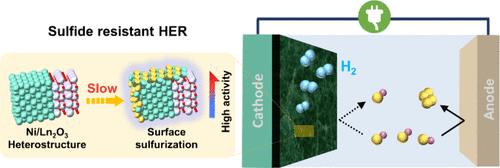当前位置:
X-MOL 学术
›
ACS Energy Lett.
›
论文详情
Our official English website, www.x-mol.net, welcomes your
feedback! (Note: you will need to create a separate account there.)
Nickel/Lanthanide Oxide Heterostructures for Sulfide-Resistant Hydrogen Evolution Electrocatalysis
ACS Energy Letters ( IF 19.3 ) Pub Date : 2024-11-01 , DOI: 10.1021/acsenergylett.4c02642 Tao Jiang, Wei Du, Zhe Chen, Ran Wang, Shaoyan Wang, Can Lei, Xueting Cao, Shuangshuang Cha, Ming Gong
ACS Energy Letters ( IF 19.3 ) Pub Date : 2024-11-01 , DOI: 10.1021/acsenergylett.4c02642 Tao Jiang, Wei Du, Zhe Chen, Ran Wang, Shaoyan Wang, Can Lei, Xueting Cao, Shuangshuang Cha, Ming Gong

|
Coupling sulfide oxidation with hydrogen evolution reaction (HER) is an alternative method of hydrogen production with ultrahigh energy efficiency using waste sulfide recovered from fossil fuel refining. However, this technology demands either membrane separation to prevent sulfide tunneling or a sulfide-resistant HER. Considering the great difficulty in constructing durable membranes in alkaline sulfide-based electrolytes, creating sulfide-resistant electrocatalysts is a more viable option, but typical metallic catalysts suffer from devastating sulfide poisoning. Herein, we created nickel/lanthanide oxide heterostructure catalysts with high HER activity, durability, and sulfide resistance, especially under high-current operating conditions. Among the lanthanide series, the oxide of earlier elements, such as lanthanum, demonstrated higher sulfide resistance and higher activities in sulfide-based electrolytes. The combinatory analysis of kinetics, impedance spectroscopy, and Raman spectroscopy revealed the major contribution of sulfide resistance from the retarded sulfidation process only pertinent to the surface, maintaining the core Ni/La2O3 structure for sustained hydrogen evolution. The surface-transformed nickel sulfide (NiS) can also form the NiS/La2O3 heterostructure that outperformed pure sulfide counterparts, contributing to the maintained long-term activity. This work points out the significance of sulfide resistance for sulfide-driven hydrogen production technology and provides a promising cathode solution for the membrane-less electrolyzer.
中文翻译:

用于抗硫化物析氢电催化的镍/镧系元素氧化物异质结构
将硫化物氧化与析氢反应 (HER) 相结合是一种利用化石燃料精炼中回收的硫化物生产氢气的替代方法,具有超高的能源效率。然而,这项技术需要膜分离以防止硫化物隧穿或耐硫化物 HER。考虑到在碱性硫化物基电解质中构建耐用膜的巨大难度,制造抗硫化物电催化剂是一种更可行的选择,但典型的金属催化剂会遭受毁灭性的硫化物中毒。在此,我们创造了具有高 HER 活性、耐久性和耐硫化物性的镍/镧系元素氧化物异质结构催化剂,尤其是在大电流操作条件下。在镧系元素中,早期元素(如镧)的氧化物表现出更高的硫化物抵抗力和更高的硫化物基电解质活性。动力学、阻抗谱和拉曼光谱的组合分析揭示了延迟硫化过程的硫化物抗性的主要贡献,仅与表面相关,维持核心 Ni/La2O3 结构以实现持续的析氢。表面转化的硫化镍 (NiS) 也可以形成 NiS/La2O3 异质结构,其性能优于纯硫化物,有助于维持长期活性。这项工作指出了抗硫化物性对硫化物驱动制氢技术的重要性,并为无膜电解槽提供了一种有前途的阴极解决方案。
更新日期:2024-11-01
中文翻译:

用于抗硫化物析氢电催化的镍/镧系元素氧化物异质结构
将硫化物氧化与析氢反应 (HER) 相结合是一种利用化石燃料精炼中回收的硫化物生产氢气的替代方法,具有超高的能源效率。然而,这项技术需要膜分离以防止硫化物隧穿或耐硫化物 HER。考虑到在碱性硫化物基电解质中构建耐用膜的巨大难度,制造抗硫化物电催化剂是一种更可行的选择,但典型的金属催化剂会遭受毁灭性的硫化物中毒。在此,我们创造了具有高 HER 活性、耐久性和耐硫化物性的镍/镧系元素氧化物异质结构催化剂,尤其是在大电流操作条件下。在镧系元素中,早期元素(如镧)的氧化物表现出更高的硫化物抵抗力和更高的硫化物基电解质活性。动力学、阻抗谱和拉曼光谱的组合分析揭示了延迟硫化过程的硫化物抗性的主要贡献,仅与表面相关,维持核心 Ni/La2O3 结构以实现持续的析氢。表面转化的硫化镍 (NiS) 也可以形成 NiS/La2O3 异质结构,其性能优于纯硫化物,有助于维持长期活性。这项工作指出了抗硫化物性对硫化物驱动制氢技术的重要性,并为无膜电解槽提供了一种有前途的阴极解决方案。


















































 京公网安备 11010802027423号
京公网安备 11010802027423号